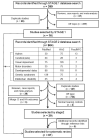Cochlear Implantation in Children with Additional Disabilities: A Systematic Review
- PMID: 37892316
- PMCID: PMC10605071
- DOI: 10.3390/children10101653
Cochlear Implantation in Children with Additional Disabilities: A Systematic Review
Abstract
This study examines the last 10 years of medical literature on the benefits of cochlear implantation in children who are deaf or hard of hearing (DHH) with additional disabilities. The most recent literature concerning cochlear implants (CIs) in DHH children with additional disabilities was systematically explored through PubMed, Embase, Scopus, PsycINFO, and Web of Science from January 2012 to July 2023. Our two-stage search strategy selected a total of 61 articles concerning CI implantation in children with several forms of additional disabilities: autism spectrum disorder, cerebral palsy, visual impairment, motor disorders, developmental delay, genetic syndromes, and intellectual disability. Overall, many children with additional disabilities benefit from CIs by acquiring greater environmental sound awareness. This, in turn, improves non-verbal communication and adaptive skills, with greater possibilities to relate to others and to be connected with the environment. Instead, despite some improvement, expressive language tends to develop more slowly and to a lesser extent compared to children affected by hearing loss only. Further studies are needed to better appreciate the specificities of each single disability and to personalize interventions, not restricting the analysis to auditory and language skills, but rather applying or developing cross-culturally validated instruments able to reliably assess the developmental trajectory and the quality of life of DHH children with additional disabilities before and after CI.
Keywords: Usher syndrome; Waardenburg syndrome; autism; cerebral palsy; cochlear implant; intellectual disability.
Conflict of interest statement
The authors declare no conflict of interest.
Figures
Similar articles
-
Outcomes and benefits of pediatric cochlear implantation in children with additional disabilities: a review and report of family influences on outcomes.Pediatric Health Med Ther. 2015 May 19;6:45-63. doi: 10.2147/PHMT.S65797. eCollection 2015. Pediatric Health Med Ther. 2015. PMID: 29388595 Free PMC article. Review.
-
Language and behavioral outcomes in children with developmental disabilities using cochlear implants.Otol Neurotol. 2012 Jul;33(5):751-60. doi: 10.1097/MAO.0b013e3182595309. Otol Neurotol. 2012. PMID: 22699986 Free PMC article.
-
Assessment and Treatment of Behavioral Disorders in Children with Hearing Loss: A Systematic Review.Otolaryngol Head Neck Surg. 2019 Jan;160(1):36-48. doi: 10.1177/0194599818797598. Epub 2018 Sep 11. Otolaryngol Head Neck Surg. 2019. PMID: 30200810 Free PMC article.
-
[Cochlear implant in children: rational, indications and cost/efficacy].Minerva Pediatr. 2013 Jun;65(3):325-39. Minerva Pediatr. 2013. PMID: 23685383 Review. Italian.
-
GJB2 mutations and additional disabilities in a pediatric cochlear implant population.Int J Pediatr Otorhinolaryngol. 2006 Mar;70(3):493-500. doi: 10.1016/j.ijporl.2005.07.026. Epub 2005 Sep 9. Int J Pediatr Otorhinolaryngol. 2006. PMID: 16154643
Cited by
-
Psychological Health of Deaf Pre-Teens and Teenagers with Cochlear Implants and Maternal Psychological Features: A Pilot Study.Healthcare (Basel). 2025 Feb 25;13(5):498. doi: 10.3390/healthcare13050498. Healthcare (Basel). 2025. PMID: 40077060 Free PMC article.
-
Early Postoperative Benefits in Receptive and Expressive Language Development After Cochlear Implantation Under 9 Months of Age in Comparison to Implantation at Later Ages.Clin Exp Otorhinolaryngol. 2024 Feb;17(1):46-55. doi: 10.21053/ceo.2024.00011. Epub 2024 Feb 8. Clin Exp Otorhinolaryngol. 2024. PMID: 38326998 Free PMC article.
-
The Role of Measuring Preoperative Social Maturation Score in Children With Additional Needs Who Underwent Cochlear Implantation.J Audiol Otol. 2024 Apr;28(2):107-113. doi: 10.7874/jao.2024.00101. Epub 2024 Apr 10. J Audiol Otol. 2024. PMID: 38695056 Free PMC article.
References
Publication types
LinkOut - more resources
Full Text Sources


